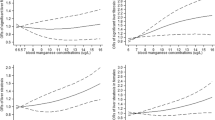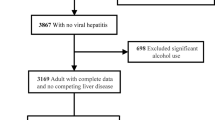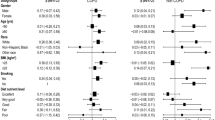Abstract
Manganese was the key activator of biological enzymes-mediated metabolic diseases (Mets)-associated pathophysiological process. Non-alcoholic fatty liver disease (NAFLD), which was the hepatic manifestation of Mets, development remained a mystery. We aimed to explore the association between blood/urine manganese exposure and NAFLD and liver fibrosis diagnosed by vibration-controlled transient elastography (VCTE). All data were extracted from National Health and Nutrition Examination Survey database (2017–2018). A total of 3580 participants with blood manganese data were enrolled and divided into four groups according to the quartile of blood manganese exposure level. In multiple logistic regression models, the higher blood manganese exposure level (groups 2, 3, and 4) had a significant positive association with NAFLD (β = 1.58, 1.30, and 1.69). In subgroup analysis, the main inversely correlation between blood manganese and NAFLD was found in participants with normal/high body mass index and high blood manganese exposure level. Moreover, in 1179 participants with urine manganese data, urine manganese exposure level presented as significantly associated with advanced liver fibrosis in models 1 and 2 (β = 2.00 and 2.02). This study showed that manganese exposure level was positively associated with NAFLD and advanced liver fibrosis among the US population. We suggested that manganese exposure level was a biomarker of the development of NAFLD.


Similar content being viewed by others
Data availability
The data used in this study are from a public database at https://www.cdc.gov/nchs/nhanes/index.htm, which can be accessed by everyone through the links provided in the paper.
Abbreviations
- NAFLD:
-
Non-alcoholic fatty liver disease
- NASH:
-
Non-alcoholic steatohepatitis
- HCC:
-
Hepatocellular carcinoma
- Mets:
-
Metabolic syndrome
- ALT:
-
Alanine aminotransferase
- FIB-4:
-
Fibrosis-4 index
- AST:
-
Aspartate aminotransferase
- VCTE:
-
Vibration-controlled transient elastography
- NHANES:
-
National Health and Nutrition Examination Survey
- NCHS:
-
National Center for Health Statistics
- CAP:
-
Controlled attenuation parameter
- HBsAg:
-
Hepatitis B virus surface antigen (HBsAg)
- HCV:
-
Hepatitis C virus
- BMI:
-
Body mass index
- MEC:
-
Mobile Examination Center
- LLOD:
-
Lowest limit of detection
References
Abdelmalek MF (2016) NAFLD: the clinical and economic burden of NAFLD: time to turn the tide. Nat Rev Gastroenterol Hepatol 13:685–686. https://doi.org/10.1038/nrgastro.2016.178
Baker MG, Simpson CD, Stover B, Sheppard L, Checkoway H, Racette BA, Seixas NS (2014) Blood manganese as an exposure biomarker: state of the evidence. J Occup Environ Hyg 11:210–217. https://doi.org/10.1080/15459624.2013.852280
Balakrishnan M, El-Serag HB, Kanwal F, Thrift AP (2017) Shiftwork is not associated with increased risk of NAFLD: findings from the national health and nutrition examination survey. Dig Dis Sci 62:526–533. https://doi.org/10.1007/s10620-016-4401-1
Bjorklund G, Chartrand MS, Aaseth J (2017) Manganese exposure and neurotoxic effects in children. Environ Res 155:380–384. https://doi.org/10.1016/j.envres.2017.03.003
Budinger D, Barral S, Soo A, Kurian MA (2021) The role of manganese dysregulation in neurological disease: emerging evidence. Lancet Neurol 20:956–968. https://doi.org/10.1016/S1474-4422(21)00238-6
Burkhard PR, Delavelle J, Du Pasquier R, Spahr L (2003) Chronic parkinsonism associated with cirrhosis: a distinct subset of acquired hepatocerebral degeneration. Arch Neurol 60:521–528. https://doi.org/10.1001/archneur.60.4.521
Carson AP, Reynolds K, Fonseca VA, Muntner P (2010) Comparison of A1C and fasting glucose criteria to diagnose diabetes among U.S. adults. Diabetes Care 33:95–97. https://doi.org/10.2337/dc09-1227
Chung SM, Moon JS, Yoon JS, Won KC, Lee HW (2020) The sex-specific effects of blood lead, mercury, and cadmium levels on hepatic steatosis and fibrosis: Korean nationwide cross-sectional study. J Trace Elem Med Biol 62:126601. https://doi.org/10.1016/j.jtemb.2020.126601
Coudriet GM, Delmastro-Greenwood MM, Previte DM, Marre ML, O’Connor EC, Novak EA, Vincent G, Mollen KP, Lee S, Dong HH, Piganelli JD (2017) Treatment with a catalytic superoxide dismutase (SOD) mimetic improves liver steatosis, insulin sensitivity, and inflammation in obesity-induced type 2 diabetes Antioxidants (basel) 6https://doi.org/10.3390/antiox6040085
de Ledinghen V, Hiriart JB, Vergniol J, Merrouche W, Bedossa P, Paradis V (2017) Controlled attenuation parameter (CAP) with the XL probe of the Fibroscan((R)): a comparative study with the m probe and liver biopsy. Dig Dis Sci 62:2569–2577. https://doi.org/10.1007/s10620-017-4638-3
Delmastro-Greenwood MM, Votyakova T, Goetzman E, Marre ML, Previte DM, Tovmasyan A, Batinic-Haberle I, Trucco MM, Piganelli JD (2013) Mn porphyrin regulation of aerobic glycolysis: implications on the activation of diabetogenic immune cells. Antioxid Redox Signal 19:1902–1915. https://doi.org/10.1089/ars.2012.5167
Deng Q, Liu J, Li Q, Chen K, Liu Z, Shen Y, Niu P, Yang Y, Zou Y, Yang X (2013) Interaction of occupational manganese exposure and alcohol drinking aggravates the increase of liver enzyme concentrations from a cross-sectional study in China. Environ Health 12:30. https://doi.org/10.1186/1476-069X-12-30
Dhanraj P, Venter C, Bester MJ, Oberholzer HM (2020) Induction of hepatic portal fibrosis, mitochondria damage, and extracellular vesicle formation in Sprague-Dawley rats exposed to copper, manganese, and mercury, alone and in combination. Ultrastruct Pathol 44:182–192. https://doi.org/10.1080/01913123.2020.1731638
Eni-Aganga I, Lanaghan ZM, Balasubramaniam M, Dash C, Pandhare J (2021) PROLIDASE: a review from discovery to its role in health and disease. Front Mol Biosci 8:723003. https://doi.org/10.3389/fmolb.2021.723003
European Association for the Study of the Liver (EASL), European Association for the Study of Diabetes (EASD), European Association for the Study of Obesity (EASO) (2016) EASL-EASD-EASO Clinical practice guidelines for the management of non-alcoholic fatty liver disease. Diabetologia 59:1121–1140. https://doi.org/10.1007/s00125-016-3902-y
Friedman SL, Neuschwander-Tetri BA, Rinella M, Sanyal AJ (2018) Mechanisms of NAFLD development and therapeutic strategies. Nat Med 24:908–922. https://doi.org/10.1038/s41591-018-0104-9
Golasik M, Wodowski G, Gomolka E, Herman M, Piekoszewski W (2014) Urine as a material for evaluation of exposure to manganese in methcathinone users. J Trace Elem Med Biol 28:338–343. https://doi.org/10.1016/j.jtemb.2014.04.005
Guillaume M, Rodriguez-Vilarrupla A, Gracia-Sancho J, Rosado E, Mancini A, Bosch J, Garcia-Pagan JC (2013) Recombinant human manganese superoxide dismutase reduces liver fibrosis and portal pressure in CCl4-cirrhotic rats. J Hepatol 58:240–246. https://doi.org/10.1016/j.jhep.2012.09.010
Hashemi SA, Alavian SM, Gholami-Fesharaki M (2016) Assessment of transient elastography (FibroScan) for diagnosis of fibrosis in non-alcoholic fatty liver disease: a systematic review and meta-analysis. Caspian J Intern Med 7:242–252
Hoehn KL, Salmon AB, Hohnen-Behrens C, Turner N, Hoy AJ, Maghzal GJ, Stocker R, Van Remmen H, Kraegen EW, Cooney GJ, Richardson AR, James DE (2009) Insulin resistance is a cellular antioxidant defense mechanism. Proc Natl Acad Sci U S A 106:17787–17792. https://doi.org/10.1073/pnas.0902380106
Huang DQ, El-Serag HB, Loomba R (2021a) Global epidemiology of NAFLD-related HCC: trends, predictions, risk factors and prevention. Nat Rev Gastroenterol Hepatol 18:223–238. https://doi.org/10.1038/s41575-020-00381-6
Huang YS, Chang TE, Perng CL, Huang YH (2021b) Genetic variations of three important antioxidative enzymes SOD2, CAT, and GPX1 in nonalcoholic steatohepatitis. J Chin Med Assoc 84:14–18. https://doi.org/10.1097/JCMA.0000000000000437
Kennedy ML, Failla ML, Smith JJ (1986) Influence of genetic obesity on tissue concentrations of zinc, copper, manganese and iron in mice. J Nutr 116:1432–1441. https://doi.org/10.1093/jn/116.8.1432
Laurent A, Nicco C, Tran VNJ, Borderie D, Chereau C, Conti F, Jaffray P, Soubrane O, Calmus Y, Weill B, Batteux F (2004) Pivotal role of superoxide anion and beneficial effect of antioxidant molecules in murine steatohepatitis. Hepatology 39:1277–1285. https://doi.org/10.1002/hep.20177
Li Y, Guo H, Wu M, Liu M (2013) Serum and dietary antioxidant status is associated with lower prevalence of the metabolic syndrome in a study in Shanghai, China. Asia Pac J Clin Nutr 22:60–68. https://doi.org/10.6133/apjcn.2013.22.1.06
Maret W (2016) The metals in the biological periodic system of the elements: concepts and conjectures Int J Mol Sci 17. https://doi.org/10.3390/ijms17010066
Martins AC, Krum BN, Queiros L, Tinkov AA, Skalny AV, Bowman AB, Aschner M (2020) Manganese in the diet: bioaccessibility, adequate intake, and neurotoxicological effects. J Agric Food Chem 68:12893–12903. https://doi.org/10.1021/acs.jafc.0c00641
Nasr P, Ignatova S, Lundberg P, Kechagias S, Ekstedt M (2021) Low hepatic manganese concentrations in patients with hepatic steatosis—a cohort study of copper, iron and manganese in liver biopsies. J Trace Elem Med Biol 67:126772. https://doi.org/10.1016/j.jtemb.2021.126772
O’Neal SL, Zheng W (2015) Manganese toxicity upon overexposure: a decade in review. Curr Environ Health Rep 2:315–328. https://doi.org/10.1007/s40572-015-0056-x
Paschos P, Paletas K (2009) Non alcoholic fatty liver disease and metabolic syndrome. Hippokratia 13:9–19
Pirozzi AV, Stellavato A, La Gatta A, Lamberti M, Schiraldi C (2016) Mancozeb, a fungicide routinely used in agriculture, worsens nonalcoholic fatty liver disease in the human HepG2 cell model. Toxicol Lett 249:1–4. https://doi.org/10.1016/j.toxlet.2016.03.004
Rajak S, Raza S, Tewari A, Sinha RA (2021) Environmental toxicants and NAFLD: a neglected yet significant relationship. Dig Dis Sci. https://doi.org/10.1007/s10620-021-07203-y
Ratziu V, Bellentani S, Cortez-Pinto H, Day C, Marchesini G (2010) A position statement on NAFLD/NASH based on the EASL 2009 special conference. J Hepatol 53:372–384. https://doi.org/10.1016/j.jhep.2010.04.008
Rezazadeh A, Yazdanparast R (2014) Prevention of nonalcoholic steatohepatitis in rats by two manganese-salen complexes. Iran Biomed J 18:41–48. https://doi.org/10.6091/ibj.1201.2013
Rezazadeh A, Yazdanparast R, Molaei M (2012) Amelioration of diet-induced nonalcoholic steatohepatitis in rats by Mn-salen complexes via reduction of oxidative stress. J Biomed Sci 19:26. https://doi.org/10.1186/1423-0127-19-26
Rhee SY, Hwang YC, Woo JT, Sinn DH, Chin SO, Chon S, Kim YS (2013) Blood lead is significantly associated with metabolic syndrome in Korean adults: an analysis based on the Korea National Health and Nutrition Examination Survey (KNHANES), 2008. Cardiovasc Diabetol 12:9. https://doi.org/10.1186/1475-2840-12-9
Rotter I, Kosik-Bogacka D, Dolegowska B, Safranow K, Lubkowska A, Laszczynska M (2015) Relationship between the concentrations of heavy metals and bioelements in aging men with metabolic syndrome. Int J Environ Res Public Health 12:3944–3961. https://doi.org/10.3390/ijerph120403944
Schmidt SB, Husted S (2019) The biochemical properties of manganese in plants. Plants 8:381
Seidelin AS, Nordestgaard BG, Tybjaerg-Hansen A, Yaghootkar H, Stender S (2022) A rare genetic variant in the manganese transporter SLC30A10 and elevated liver enzymes in the general population. Hepatol Int 16:702–711. https://doi.org/10.1007/s12072-022-10331-w
The essential element manganese, oxidative stress, and metabolic diseases: links and interactions Oxid Med Cell Longev 2018 7580707. https://doi.org/10.1155/2018/7580707
Wahlang B, Appana S, Falkner KC, Mcclain CJ, Brock G, Cave MC (2020) Insecticide and metal exposures are associated with a surrogate biomarker for non-alcoholic fatty liver disease in the National Health and Nutrition Examination Survey 2003–2004. Environ Sci Pollut Res Int 27:6476–6487. https://doi.org/10.1007/s11356-019-07066-x
Wong VW, Vergniol J, Wong GL, Foucher J, Chan HL, Le Bail B, Choi PC, Kowo M, Chan AW, Merrouche W, Sung JJ, de Ledinghen V (2010) Diagnosis of fibrosis and cirrhosis using liver stiffness measurement in nonalcoholic fatty liver disease. Hepatology 51:454–462. https://doi.org/10.1002/hep.23312
Younossi ZM, Koenig AB, Abdelatif D, Fazel Y, Henry L, Wymer M (2016) Global epidemiology of nonalcoholic fatty liver disease—meta-analytic assessment of prevalence, incidence, and outcomes. Hepatology 64:73–84. https://doi.org/10.1002/hep.28431
Zhang D, Wu S, Lan Y, Chen S, Wang Y, Sun Y, Liao W, Wang L (2022) Blood manganese and nonalcoholic fatty liver disease: a cohort-based case-control study. Chemosphere 287:132316. https://doi.org/10.1016/j.chemosphere.2021.132316
Zhao M, Ge X, Xu J, Li A, Mei Y, Yin G, Wu J, Liu X, Wei L, Xu Q (2022) Association between urine metals and liver function biomarkers in Northeast China: a cross-sectional study. Ecotoxicol Environ Saf 231:113163. https://doi.org/10.1016/j.ecoenv.2022.113163
Acknowledgements
The authors thank all the staff and participants in NHAENS 2017–2018 for their contribution of donation, collection, and sharing data.
Funding
This work was supported by the National Natural Science Foundation of China (Grant Number: 82170292), and the Scientific research project of Hunan Provincial Department of Finance (Grant Number: 202127).
Author information
Authors and Affiliations
Contributions
Jie Liu: analysis the data and writing—original draft.
Liao Tan: analysis the data and software.
Zhaoya Liu: revision of the manuscript and validation.
Ruizheng Shi: validation, supervision, writing (review and editing), project administration.
Corresponding author
Ethics declarations
Ethics approval and consent to participate
The NHANES agreement has been reviewed and approved by the NCHS Research Ethics Committee. All participants provided written informed consent before participating.
Consent for publication
The manuscript is approved by all authors for publication.
Competing interests
The authors declare no or competing interests.
Additional information
Responsible Editor: Lotfi Aleya
Publisher's note
Springer Nature remains neutral with regard to jurisdictional claims in published maps and institutional affiliations.
Headings
• Manganese exposure has been a growing environmental problem and a serious threat to human health which was closely related to metabolic diseases, especially in NAFLD.
• High blood manganese exposure was associated with NAFLD diagnosed by vibration-controlled transient elastography.
• Participants with higher urine manganese exposure had a high percentage of advanced liver fibrosis.
Supplementary Information
Below is the link to the electronic supplementary material.
Rights and permissions
Springer Nature or its licensor (e.g. a society or other partner) holds exclusive rights to this article under a publishing agreement with the author(s) or other rightsholder(s); author self-archiving of the accepted manuscript version of this article is solely governed by the terms of such publishing agreement and applicable law.
About this article
Cite this article
Liu, J., Tan, L., Liu, Z. et al. Blood and urine manganese exposure in non-alcoholic fatty liver disease and advanced liver fibrosis: an observational study. Environ Sci Pollut Res 30, 22222–22231 (2023). https://doi.org/10.1007/s11356-022-23630-4
Received:
Accepted:
Published:
Issue Date:
DOI: https://doi.org/10.1007/s11356-022-23630-4




